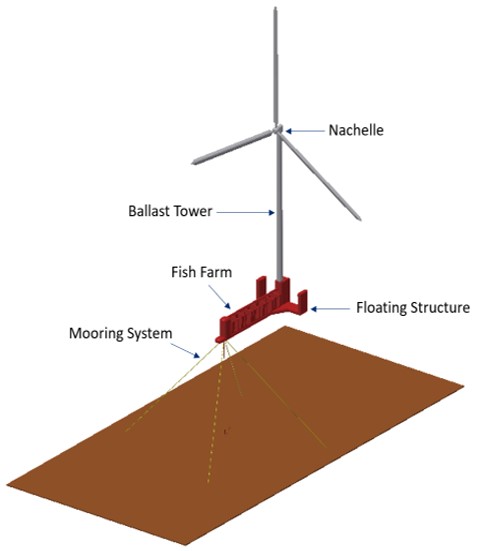Floating Wind Structure
The Scotstream floating wind structure is a weathervaning semisubmersible design.
The main structural members are submerged and the floats are designed to provide the minimal water plane area. This results in a very stable operating platform.
The Bow Float supports the load from the mooring system and dynamic umbilical. The float also accommodates most of the wave loading, in order to protect the rest of the structure from wave impact.
The Centre Float is positioned at the stern and supports the weight of the Wind Turbine.
The two Outrigger Floats counteract any roll on the structure during operation.
The structure length between the Bow and Centre floats will be specified to help reduce the pitch motion during operation.
The main access for personnel will be at the stern of the structure. The vessel can be positioned in the lee of the Centre float to protect it from the weather.
The structure can be design to house an integrated Offshore Aquaculture system.

Lowering the Levelized Cost of Electricity (LCOE)
The main challenge facing the development of floating wind systems is the high Capex costs initially and then the high Opex cost during the service lifetime, resulting in a high Levelized Cost of Energy (LCOE). The LCOE for floating wind systems is currently too high and needs to reduce down to the £40/MWh for a bottom fixed inshore wind system.
In order to reduce the LCOE the capital cost of the wind turbine, structure and mooring system will require to be considerably reduced.
The operating cost for planned and unplanned maintenance will require to be minimized. Component replacement should be performed offshore, rather than requiring the structure to be returned to port for component replacement. The generating capacity of the floating assembly should be maximized. The current systems are rated at about 14 MW. This capacity should be eventually increased to 20 MW.
The Spintral system is a new floating wind system that has been designed to address these issues – in order to lower the LCOE for the industry. The design is based on offshore oil and gas technology that has been adapted to suit the specific requirements for floating renewable systems – at a lower cost base.
The Scotstream approach is to license the technology on a global basis. This will enable any party that is interested in developing renewable energy sites to have direct access to the technology and manufacture the devices in their own local area. This should open up the market, reduce costs and speed up implementation of the technology worldwide.

